Random, interesting studies
-
@Mauritio interesting intuitively i noticed eating high carb only meal as last meal doesnt hit right , after pm rise in stress
and i was thinking, it probably exists to increase thermogenesis when the sun is set, with fats being better at that , matches your last part (wouldnt match the mice tho with active time at night, maybe for if they stop moving as much then)
serine has effect on resetting circadian rhythm
-
Very interesting! I didn't know he had posted about it.
Ironically those on Kruse's side say that breakfast should be high in protein and fat.
I used to think that consuming most carbs during the day was great just for the increased presence of red/infrared from the sun, I didn't really need another reason (but good thing there is).
Ps.: Now that I've seen that you're the metabolic_monster on x
-
@cs3000 I tried only eating carbs today until dinner for the first time. And it was great.
Energy was good. Seems to be good for the liver and digestive system. Felt like my body could regenerate, like a healthy kind of fasting.Protein restriction increases autophagy.
I was craving protein and milk during the afternoon, but nothing crazy. Small bouts of hypoglycemia as well .
i have to read more on macro nutrient timing and circadian rhythms. Seems very interesting.
Also the randle cycle .
I always dismissed it, because some organ is always burning carbs/ fat, no matter what you ingest. -
@cs3000 said in Random, interesting studies:
serine has effect on resetting circadian rhythm
It seems so !
Actually very many substances have an effect on circadian rhythm. Everything that affects Nrf2. IIRC it affects CYR ,which then affects CLOCK AND BMAL1 .
Sulforaphane can induce days long nrf2 activation , which really messed with my sleep.
Serine seems to be a Nrf2 agonist as well...
"Additionally, serine supplementation increased nuclear nrf2 expression in IPEC-J2 cells. These results suggested that serine alleviates oxidative stress through supporting glutathione synthesis and activating nrf2 signaling."Apigenin and Luteolin are nrf2 antagonists.
-
Saffron can delay and treat macular degeneration (with no side effects).
abstract:
https://pubmed.ncbi.nlm.nih.gov/24819927/
full article:
https://sci-hub.se/10.1017/s0952523814000108From the paper:
Chemically, saffron is known to contain more than 150 volatile and aroma-yielding
compounds and many non-volatile biologically active components, including carotenoids (zeaxanthin and crocetin) and various alphaand beta-carotenes. Its golden yellow-orange color comes from alpha-crocin, a water soluble beta-gentobiose (sugar) ester of crocetin. Its flavor arises from the glycoside picrocrocin, a molecule containing safranal and a carbohydrate. Its most potent antioxidant
ingredients appear to be crocin, and crocetin, a carotenoid dicarboxylic acid which forms the core of crocin. Several actions of
crocin on mammalian tissues have been reported including antiapoptotic activity and increased oxygen diffusivity (see Maccarone
et al., 2008 and Di Marco et al., 2013 ). Kanakis et al. ( 2007 )
showed that metabolites of saffron bind directly to DNA and induce
its partial conformation to beta-DNA, thereby protecting the cell
from damage. Saffron has been shown to have anti-infl ammatory
actions, including for example the inhibition of tissue necrosis
factor (Nam et al., 2010 ). Based on these observations, it is clear
that the saffron extract does not act as a simple antioxidant. The
peculiar characteristics of saffron components support the hypothesis that saffron has complex mechanisms of action ranging from
antioxidant activity to direct control of gene expression, as also
suggested by microarray experiments (Natoli et al., 2010 ).I asked ai about saffron's role inhibiting lipid peroxidation:
Saffron inhibits lipid peroxidation through multiple mechanisms involving its bioactive compounds, particularly safranal and crocin, which counteract oxidative stress and protect cellular membranes.
Direct Antioxidant Activity
Free Radical Scavenging: Safranal, a key component of saffron, neutralizes reactive oxygen species (ROS) by donating hydrogen atoms or electrons, preventing ROS from initiating lipid peroxidation in polyunsaturated fatty acid (PUFA)-rich membranes. Its conjugated structure enables efficient quenching of singlet oxygen through energy transfer.Enhancing Endogenous Antioxidants: Saffron increases levels of glutathione (GSH) and activity of antioxidant enzymes like superoxide dismutase (SOD) and catalase, which degrade peroxides and superoxides before they damage lipids.
Inhibition of Pro-Oxidant Pathways
Arachidonic Acid Metabolism: Saffron reduces malondialdehyde (MDA), a byproduct of lipid peroxidation, by suppressing arachidonic acid oxidation pathways in platelets and other tissues.Enzyme Interactions: Molecular docking studies suggest safranal binds to enzymes like collagenase and hyaluronidase, potentially interfering with oxidative cascades that exacerbate lipid peroxidation.
Protection in Biological Systems
Neuroprotection: In animal models, saffron mitigates lipid peroxidation in brain tissues by restoring antioxidant enzyme activity and reducing MDA levels, critical in PUFA-rich neural membranes.Platelet Membrane Stabilization: Saffron extract inhibits iron-ascorbate-induced lipid peroxidation in platelet membranes, preserving membrane integrity.
These mechanisms collectively highlight saffron’s role as a natural antioxidant, targeting both ROS and downstream peroxidation processes in lipid-rich environments.
-
Strong pro-sexual effects of Massularia acuminata. Also increases Testosterone on the highest dose.
https://pmc.ncbi.nlm.nih.gov/articles/PMC3022175/#sec3
Increases testosterone, testicular cholesterol and almost triples the testicle- body weight ratio.
https://pubmed.ncbi.nlm.nih.gov/18602232/Mixed results depending on dosage
https://pubmed.ncbi.nlm.nih.gov/21951198/Might cause elevation in liver enzymes.
https://www.researchgate.net/publication/375867305_Effects_of_Aqueous_Stem_Extract_of_Massularia_Acuminata_on_Some_Liver_Function_Indices_of_Male_RatsIn this study it seems liver protective
Seems safe in lower doses
https://www.researchgate.net/publication/356879871_HAEMATOLOGICAL_BIOCHEMICAL_AND_HISTOLOGICAL_TOXICITY_OF_THE_ETHANOLIC_EXTRACT_OF_MASSULARIA_ACUMINATA_G_DON_BULLOCK_EX_HOLY_RUBIACEAE_STEMS_IN_RAT -
Bulbine natalensis
Is another interesting candidate.
Increases testosterone 3-4bfold, lowers estrogen and increases progesterone slightly. Doesn't affect prolactin.
This is only in lower doses (this study 25 /50mg/kg dose) at 100mg/kg it had negative effects.
https://pubmed.ncbi.nlm.nih.gov/19410284/Might cause some slight atrophy in liver and kidneys, mostly at higher doses.
https://pubmed.ncbi.nlm.nih.gov/19735182/Completely safe in human males , 28 days, 650mg/d
https://pmc.ncbi.nlm.nih.gov/articles/PMC3500755/ -
Bees Wax + Policosanol
The alcoholic fraction of Bees wax /honeycomb is policosanol. Here's a threat on policosanols benefits:
https://lowtoxinforum.com/threads/the-policosanols-thread.35360/Beeswax alcohol (BWA), a mixture of six long-chain aliphatic alcohols (tetracosanol, hexacosanol, octacosanol, triacontanol, dotriacontanol, and tetratriacontanol)
https://pmc.ncbi.nlm.nih.gov/articles/PMC11672924/
I never thought about it like that. Probably pretty silly to not eat the honey comb . Until about 1900 it was common to do that .
How much policosanols is in bees wax / honeycomb?
It seems to be about 1%.
That's a big dose. 100mg from a 10g dose of honey comb/wax .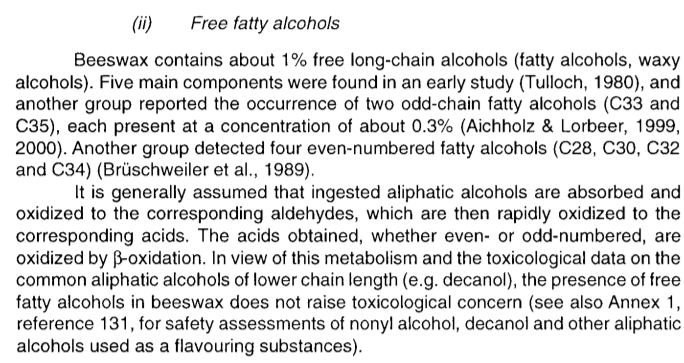
In this study in German they tested several different bees wax samples from Switzerland, China, Canada and Brasil and they all contained 1% of fattyalcohols (german: "Fettalkohole") .
So a 1% mark of policosanol seems to be globally reliable.
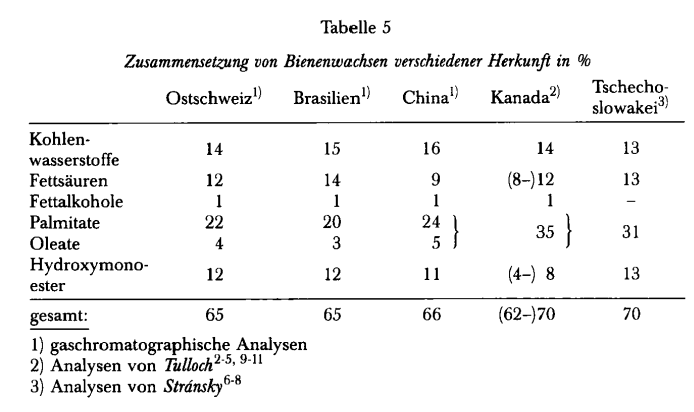
-
@Mauritio had potential but we cant digest the wax / comb so wouldnt go into system, high in sugarcane wax too , i looked it up if you could extract it by melting the beeswax in hot water. but policosanol form in beeswax is an ester not bioavailable for us until processed / hydrolysed
as a supplement its a good effect on helping lower atherosclerosis without the extra fuckery statins give (and actually shows regression combined with low fat diet) 10mg - 40mg is about the same effect for that (the content of the policosanol matters needs enough octacosanol, and if its ester form probably not absorbed much) (octacosanol is most active part, #3 in https://cs3001.substack.com/p/some-health-finds-3) -
@cs3000 Oh damn so close and yet so far

Do you have a source for it beeing indigestible for us ? -
For those saying DNP is safe and only careless people die from it.
-
"This study concludes that the dietary recommendation to avoid consuming coconut oil due to its effects on lipid parameters is not justified,"
-
@Mauritio said in Random, interesting studies:
@cs3000 Oh damn so close and yet so far

Do you have a source for it beeing indigestible for us ?@Mauritio @cs3000 i have eaten honey comb multiples Times, a good part of the wax do not melt in the mouth even if you chew it very long, and the part that you swallow often end up as solid flakes in your intestins that cause intestinal irritations and nightmare if you swallow alot. Comb from more recent hives and recently harvested Can be much softer. If you look at hunters gatherers eating honey comb in documentary they spit back the comb. part of beekeepers use plastic/synthetic materials as a base for bees to build the hive on, therefore some honey comb contain a sheet of plastic/synthetic materials in the middle. It is possible you absorb part of what is in the wax, as wax that is colored like orange will end up white/yellowish if you chew it alot even if you dont swallow it
-
@Mauritio
one in dogs vs birds (fig 2 , its not policosanol tho general
fatty acid esters absorbed a little but the fatty alcohol ester didnt https://www.researchgate.net/publication/21739344_Comparative_aspects_of_lipid_digestion_and_absorption_Physiological_correlates_of_wax_ester_digestionbut looked a bit further for specific, rats can digest even more of it if its esterified specific to oleic acid
but thats synthetic esterification not bound with oleic acid normally https://grasasyaceites.revistas.csic.es/index.php/grasasyaceites/article/view/1388 , couldnt find if humans could absorb some but theres a case of a women with gastric blockage who ate a lot of honeycomb so at least a lot goes undigested
https://pmc.ncbi.nlm.nih.gov/articles/PMC2740191/#s02
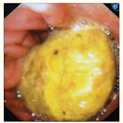
was still worth posting your post now i know more about it & wouldnt have@Mauritio said in Random, interesting studies:
for it beeing indigestible for us ?


study from that megathread showing good anti blood clotting property of policosanol https://pubmed.ncbi.nlm.nih.gov/9425618/
-
@cs3000 if its extracted from sugarcane wax its mostly the free form policosanol with high % octacosanol and more digestible https://pubmed.ncbi.nlm.nih.gov/12423895/ maybe 7% as esters in the wax. has b-sitosterol which is anti androgen but <1% of the wax
-
@cs3000 said in Random, interesting studies:
@Mauritio had potential but we cant digest the wax / comb so wouldnt go into system, high in sugarcane wax too , i looked it up if you could extract it by melting the beeswax in hot water. but policosanol form in beeswax is an ester not bioavailable for us until processed / hydrolysed
as a supplement its a good effect on helping lower atherosclerosis without the extra fuckery statins give (and actually shows regression combined with low fat diet) 10mg - 40mg is about the same effect for that (the content of the policosanol matters needs enough octacosanol, and if its ester form probably not absorbed much) (octacosanol is most active part, #3 in https://cs3001.substack.com/p/some-health-finds-3)Doesn’t the hot water cause hydrolysis ?
-
Anybody tried bees bread ?
In this study it did wonders for steroid health.
They gave mice on a HFD about 5-7g(HED) of bees bread and it completely rescued the levels of their steroidogenic enzymes.
Not only that, in many cases, giving them bees bread, increased the values above the normal control group.Testosterone was increased by about 60% above control levels.
StaR mRNA levels doubled !
Unfortunately estrogen was increased as well, but only to the level of the control group not above that.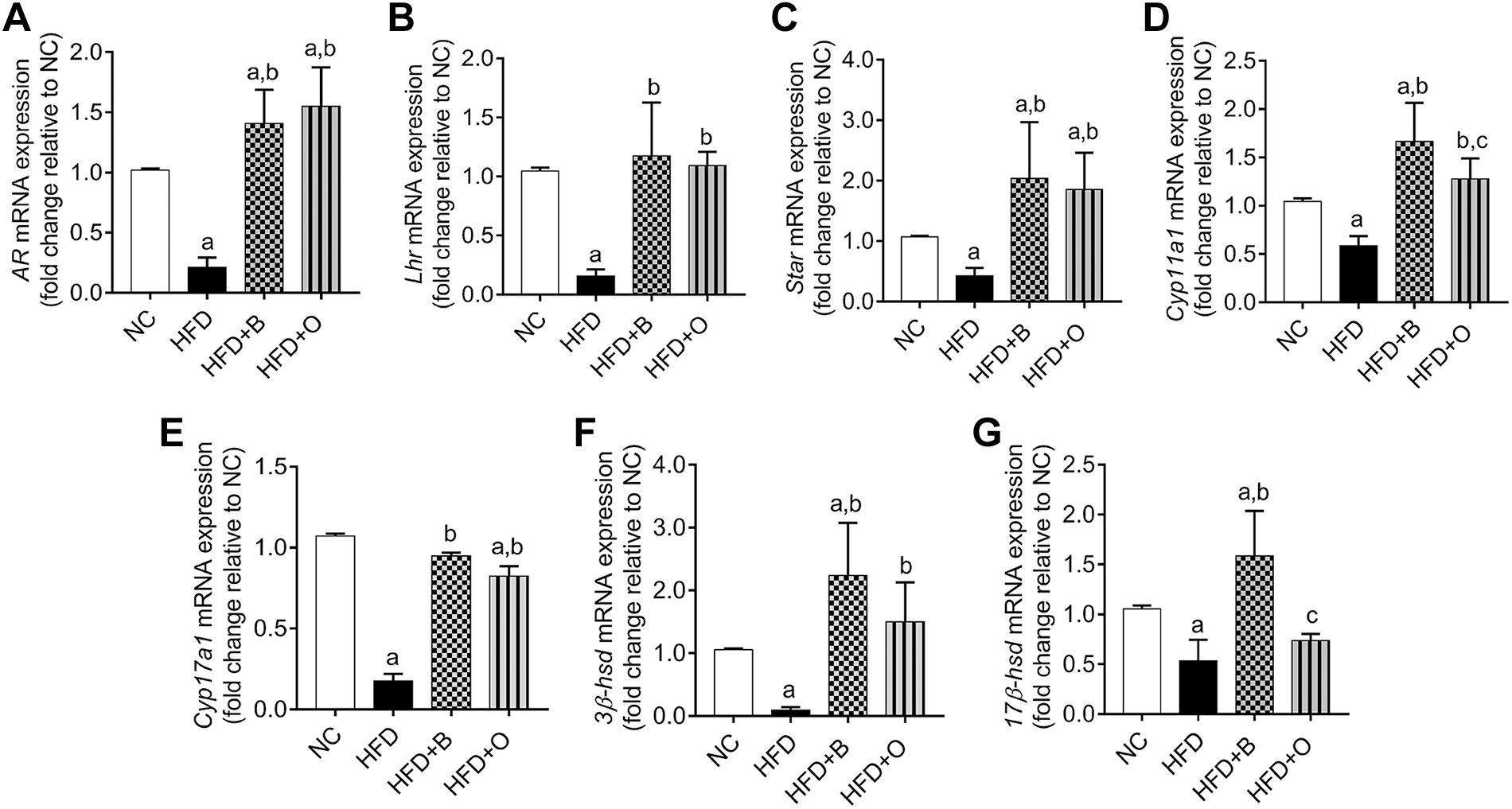
-
@Mauritio said in Random, interesting studies:
Anybody tried bees bread ?
I did, it Can taste much better than basic honey comb that has only wax and honey, basic honey comb is often to acidic and taste aint the best in most case compare to some honey in jar and some beesbread
-
@Mauritio honey /most bee products /chyrsin rich foods generally increase testosterone.
-
@alfredoolivas said in Random, interesting studies:
Doesn’t the hot water cause hydrolysis ?
apparently too slow by itself so they do extra processing
@Mauritio said in Random, interesting studies:
Anybody tried bees bread ?
In this study it did wonders for steroid health.nice , & a potent effect really fast in a diabetes model. normalised by 3 days. fastest effect ive seen
STZ model = destruction of pancreas cells so i guess its most relevant to type 1 , or if someone with type 2 has lacking pancreatic islet cells too as part of their problem. full damage was done initially so shows good effect
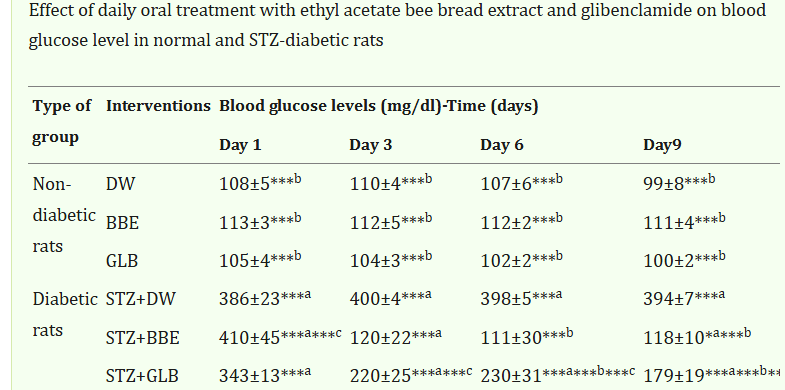
they used an extract ~30mg polyphenols 5mg flavanols per gram so maybe ~ 5g bee bread for 1g of extract
composition varies a lot by location if it was the polyphenols giving most of the effect even in same country by region,
theirs was high inkaempferol-3-O-di-rhamnosideIsorhamnetin-O-hexosyl-O-rutinosidehttps://pmc.ncbi.nlm.nih.gov/articles/PMC8264221/#sec7
and if you believe the results,
they showed its acute effect (didnt lower blood sugar when not elevated)
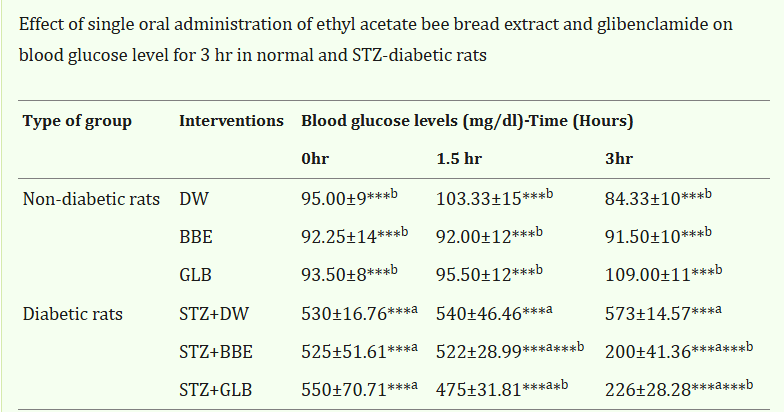
Which is odd. because its not lowering glucose in non diabetic rats so its not acting like insulin right? unless things are effectively counteracting it in the normal group because it would be crashing otherwise from insulin secretion. (at 3hrs in the DW group they had lower blood sugar though 84 vs 92)
unlikely enough islet cells left from the damage to stimulate insulin secretion for such a drastic change in both of the groups, which is what GLB doe? idk maybe there is but they're clearly wrecked from such high glucose at 0hr. 3 hours isnt enough time to regenerate the islet cell damage